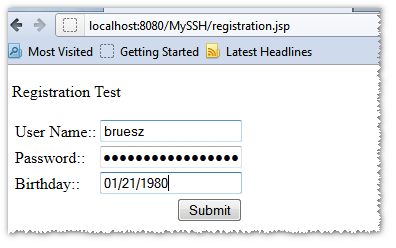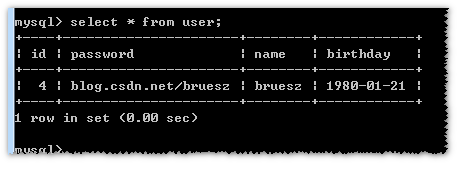版权声明:欢迎转载,转载请注明作者和出处 https://blog.csdn.net/bruesz/article/details/7011644
坑爹呀...保存的一篇掉了,只得重写....
话说前两篇介绍了怎么配置Struts和Hibernate,这篇就用一个简单的例子:用户注册,将这两种技术整合起来。
1. 写一个注册界面registration.jsp,这里用到了Java国际化的一些标记,能看懂的就看,看不懂的先别理他....
<%@ page language="java" contentType="text/html; charset=UTF-8"
pageEncoding="UTF-8"%>
<%@ taglib uri="/struts-tags" prefix="s" %>
<%
String path = request.getContextPath();
String basePath = request.getScheme()+"://"+request.getServerName()+":"+request.getServerPort()+path+"/";
%>
<!DOCTYPE html PUBLIC "-//W3C//DTD HTML 4.01 Transitional//EN" "http://www.w3.org/TR/html4/loose.dtd">
<html>
<head>
<base href="<%=basePath%>">
<title>Insert title here</title>
<meta http-equiv="Content-Type" content="text/html; charset=UTF-8">
<meta http-equiv="pragma" content="no-cache">
<meta http-equiv="cache-control" content="no-cache">
<meta http-equiv="expires" content="0">
<meta http-equiv="keywords" content="keyword1,keyword2,keyword3">
<meta http-equiv="description" content="This is my page">
</head>
<body>
<p>Registration Test</p>
<s:form name="registrationFrm" action="registration">
<s:textfield name="name" key="username"></s:textfield>
<s:password name="password" key="password"></s:password>
<s:textfield name="birthday" key="birthday"/>
<s:submit label="submit"></s:submit>
</s:form>
<s:actionerror/>
</body>
</html>2. 在struts.xml中增加一个action的mapping
<action name="registration" class="test.RegistrationAction">
<result name="success" >index.jsp</result>
<result name="input">registration.jsp</result>
<result name="error">registration.jsp</result>
</action>
3. 增加一个注册的action类
package test;
import com.opensymphony.xwork2.ActionSupport;
import com.opensymphony.xwork2.ModelDriven;
import com.test.model.User;
import com.test.service.UserService;
public class RegistrationAction extends ActionSupport implements ModelDriven<User> {
private User user = new User();
public User getModel() {
return user;
}
public String execute()
{
System.out.println(user.toString());
UserService us = new UserService();
us.saveUser(user);
return SUCCESS;
}
}
上面的类还引用了一个业务逻辑类,如下:
package com.test.service;
import com.test.dao.UserDao;
import com.test.model.User;
public class UserService {
private UserDao userdao = new UserDao();
public void saveUser(User user)
{
userdao.saveUser(user);
}
public User getUserInfo(String username)
{
User user = userdao.getUserbyName(username);
return user;
}
public boolean login(String username, String password)
{
User user = userdao.getUserbyLoginInfo(username, password);
if (null != user)
{
return true;
}else{
return false;
}
}
}
跟数据库的打交道的DAO类:
package com.test.dao;
import org.hibernate.Query;
import org.hibernate.Session;
import org.hibernate.SessionFactory;
import org.hibernate.Transaction;
import org.hibernate.cfg.Configuration;
import com.test.model.User;
public class UserDao {
private SessionFactory factory;
public UserDao()
{
Configuration cfg = new Configuration().configure();
this.factory = cfg.buildSessionFactory();
}
public void saveUser (User user)
{
Session session = this.openSession();
Transaction tx = null;
try
{
//打开事务
tx = session.beginTransaction();
session.save(user);
//关闭事务
tx.commit();
}catch(Exception ex)
{
tx.rollback();
ex.printStackTrace();
}finally{
session.close();
}
}
public User getUserbyName(String username)
{
Session session = this.openSession();
String hql = "from user where name=:name";
Query query = session.createQuery(hql);
query.setString("name", username);
//用uniqueResult获取唯一对象,或者用list获取对象列表
User user = (User) query.uniqueResult();
return user;
}
public User getUserbyLoginInfo(String username, String password)
{
Session session = this.openSession();
String hql = "from User where name=:name and password=:password";
Query query = session.createQuery(hql);
query.setString("name", username);
query.setString("password", password);
//用uniqueResult获取唯一对象,或者用list获取对象列表
User user = (User) query.uniqueResult();
return user;
}
public Session openSession()
{
Session session = this.factory.openSession();
return session;
}
}
4. 注册成功后的显示jsp文件:
index.jsp
<%@ page language="java" contentType="text/html; charset=UTF-8" pageEncoding="UTF-8"%>
<%@ taglib uri="/struts-tags" prefix="s" %>
<%
String path = request.getContextPath();
String basePath = request.getScheme()+"://"+request.getServerName()+":"+request.getServerPort()+path+"/";
%>
<!DOCTYPE html PUBLIC "-//W3C//DTD HTML 4.01 Transitional//EN" "http://www.w3.org/TR/html4/loose.dtd">
<html>
<head>
<base href="<%=basePath%>">
<title>SSH2 - Index</title>
<meta http-equiv="Content-Type" content="text/html; charset=UTF-8">
<meta http-equiv="pragma" content="no-cache">
<meta http-equiv="cache-control" content="no-cache">
<meta http-equiv="expires" content="0">
<meta http-equiv="keywords" content="easyTalk">
<meta http-equiv="description" content="This is my page">
</head>
<body>
<p> <s:text name="username" /> <s:property value="#request.name"/></p>
<p> <s:text name="password" /> <s:property value="#request.password" />
<p> <s:text name="birthday" /> <s:property value="#request.brithday"/>
</body>
</html>5. 开始验证功能:
注册界面:
注册成功后的界面(这里有点奇怪,日期类型的参数传不过来,容后再看..):

源代码下载: 点此下载